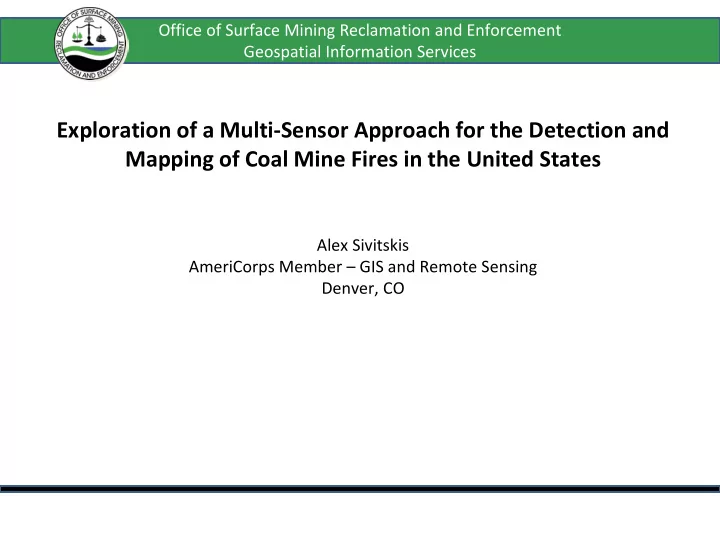

Office of Surface Mining Reclamation and Enforcement Geospatial Information Services Exploration of a Multi-Sensor Approach for the Detection and Mapping of Coal Mine Fires in the United States Alex Sivitskis AmeriCorps Member – GIS and Remote Sensing Denver, CO
Office of Surface Mining Reclamation and Enforcement Geospatial Information Services Coal Fires: A Global Occurrence • Worldwide distribution • Natural spontaneous combustion • Influenced by mining activity From Huo 2015
Office of Surface Mining Reclamation and Enforcement Geospatial Information Services The Costs of Coal Fires Environmental: • Subsidence • Scarred landscapes • Pollution Public Health: • Respiratory • Dangerous temperatures Economic: • Loss of resources Often poorly reported Need citation
OSMRE Current Fire Database
Office of Surface Mining Reclamation and Enforcement Geospatial Information Services Investigation Proposal • Problem – Incomplete records – Limited scope of spatial data • Remote Sensing Solution – Improve spatial data – Enhance understanding of fire dynamics and history – Inform future reclamation efforts & decision making
Office of Surface Mining Reclamation and Enforcement Geospatial Information Services Remote Sensing of Coal Fires • Airborne Thermal Infrared – In use since the 1960’s – High spatial resolution and control – Individual tasking • Spaceborne Thermal Infrared – Coarser spatial resolution – Constant collection – Freely available data From Kolker 2009
Office of Surface Mining Reclamation and Enforcement Geospatial Information Services Generalized Workflow • Acquire Data – Process to temperature • Find thermal anomaly – Differentiate from background temperatures • Geographic subsets • Hotspot image stacking • Delineate a fire boundary
Office of Surface Mining Reclamation and Enforcement Geospatial Information Services Common Sensors in Coal Fire Research • ASTER – Derived kinetic surface temperature (KST) products – 90m spatial res – Success mapping surface fires • Landsat 7 & 8 – Requires preprocessing for KST – 30m spatial resolution – Success mapping of underground fires
Office of Surface Mining Reclamation and Enforcement Geospatial Information Services ASTER • Basics – Advanced Spaceborne Thermal Emission and Reflection Radiometer – Wide scale applications: • Archaeology • Geology • Hydrology • Natural Hazards • Landuse • Bands – 3 – 15 m bands in Visible & Near-infrared (VNIR) – 6 – 30 m Shortwave Infrared (SWIR)* – 5 – 90 m Thermal Infrared (TIR)
Office of Surface Mining Reclamation and Enforcement Geospatial Information Services Wise Hill Fire (Craig CO) • Past fire suppression initiatives • Four distinct fire zones • Features including vents and fractures • CO levels at ~200-300ppm • Elevated surface temperatures from 125-600°F ASTER Detection From Renner 2005 Scene Used: AST_08_00310232011050536 _20161201080942_27454 Method: geographic subsets
Office of Surface Mining Reclamation and Enforcement Geospatial Information Services Wise Hill Fire Detection: Geographic Subsets
Office of Surface Mining Reclamation and Enforcement Geospatial Information Services Wise Hill Detection Results From Renner 2005 2005 field derived Fire Area ASTER TIR Detection
Office of Surface Mining Reclamation and Enforcement Geospatial Information Services Landsat
Office of Surface Mining Reclamation and Enforcement Geospatial Information Services Landsat 7 Data Methodology • Image Processing – Convert DN to at sensor radiance (ASR) (Irish 2000) – Convert ASR to at sensor brightness temperature (ASBT) (Irish 2000) – Calculate Emissivity (Choudhury et al. 1994) 1 frame • Proportion of Vegetation from NDVI – Convert to surface kinetic temperature (Prakash 2011) • Fire Detection – Multi –temporal approach 4 frame stack • Ten scenes collected 2002-2003 – Set threshold & identify hotspots • Experimentally set at 10% (Prakash 2011) – Image Stacking (Prakash 2011) – Delineate fire area boundary 16 frame stack
Office of Surface Mining Reclamation and Enforcement Geospatial Information Services IHI #3 Fire (Rifle CO) • Numerous abatement activities • East and West fire zone • Features including vents, fractures, subsidence • Elevated surface temperatures from 125-500°F Landsat 7 ETM+ Detection Scene: ten “cloud-free” scenes from 2002-2003 From Renner 2005 Method: hotspot image stacking
Office of Surface Mining Reclamation and Enforcement Geospatial Information Services IHI#3 Fire Detection: Hotspot Image Stacking
Office of Surface Mining Reclamation and Enforcement Geospatial Information Services IHI#3 Detection Results From Renner 2005 Landsat 7 ETM+ TIR Detection 2005 field derived Fire Area
Office of Surface Mining Reclamation and Enforcement Geospatial Information Services Conclusions • Need for improvement in mine fire spatial data • TIR Spaceborne Remote sensing can: – Delineate fire boundaries – Enhance multi-temporal studies – Future: be streamlined for time & cost efficiency
Office of Surface Mining Reclamation and Enforcement Geospatial Information Services Future Steps: Automation via Google Earth Engine
Office of Surface Mining Reclamation and Enforcement Geospatial Information Services Works Referenced & Additional Reading • Choudhury, Bhaskar J., et al. "Relations between evaporation coefficients and vegetation indices studied by model simulations." Remote sensing of environment 50.1 (1994): 1-17. • Harriman, Lindsey. Terrain Data at the LP DAAC (fire applications) Webinar. Accessed 03/06/2017 : https://lpdaac.usgs.gov/terrain_data_lp_daac_fire_applications • Huo, Hongyuan, et al. "A Study of Coal Fire Propagation with Remotely Sensed Thermal Infrared Data." Remote Sensing 7.3 (2015): 3088-3113. • Huo, Hongyuan, et al. "Detection of coal fire dynamics and propagation direction from multi-temporal nighttime Landsat SWIR and TIR data: A case study on the Rujigou coalfield, Northwest (NW) China." Remote Sensing 6.2 (2014): 1234-1259. • Irish, Richard R. "Landsat 7 science data users handbook." National Aeronautics and Space Administration, Report 2000 (2000): 415-430. • Kolker, Allan, et al. Emissions from coal fires and their impact on the environment . No. 2009-3084. US Geological Survey, 2009. • Prakash, Anupma, et al. "A remote sensing and GIS based investigation of a boreal forest coal fire." International Journal of Coal Geology 86.1 (2011): 79-86. • Renner, Steve. "Report on the status of fires at abandoned underground coal mines in Colorado." Unpublished report of the Colorado Division of Mineral and Geology, 41pp (2005). • Stracher, Glenn B., Anupma Prakash, and Ellina V. Sokol, eds. Coal and Peat Fires: A Global Perspective: Volume 3: Case Studies–Coal Fires . Elsevier, 2014.
Recommend
More recommend